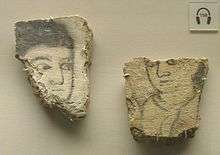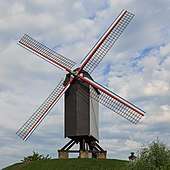Abbasid Caliphate
The Abbasid Caliphate (/əˈbæsɪd/ or /ˈæbəsɪd/ Arabic: اَلْخِلَافَةُ ٱلْعَبَّاسِيَّةُ, al-Khilāfah al-ʿAbbāsīyah) was the third caliphate to succeed the Islamic prophet Muhammad. It was founded by a dynasty descended from Muhammad's uncle, Abbas ibn Abdul-Muttalib (566–653 CE), from whom the dynasty takes its name.[2] They ruled as caliphs for most of the caliphate from their capital in Baghdad in modern-day Iraq, after having overthrown the Umayyad Caliphate in the Abbasid Revolution of 750 CE (132 AH). The Abbasid Caliphate first centered its government in Kufa, modern-day Iraq, but in 762 the caliph Al-Mansur founded the city of Baghdad, near the ancient Sasanian capital city of Ctesiphon. The Abbasid period was marked by reliance on Persian bureaucrats (notably the Barmakid family) for governing the territories as well as an increasing inclusion of non-Arab Muslims in the ummah (national community). Persian customs were broadly adopted by the ruling elite, and they began patronage of artists and scholars.[3] Baghdad became a center of science, culture, philosophy and invention in what became known as the Golden Age of Islam.
Abbasid Caliphate اَلْخِلَافَةُ ٱلْعَبَّاسِيَّةُ | |||||||||||||||||||||||||
|---|---|---|---|---|---|---|---|---|---|---|---|---|---|---|---|---|---|---|---|---|---|---|---|---|---|
| |||||||||||||||||||||||||
 | |||||||||||||||||||||||||
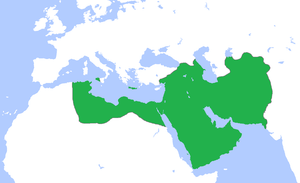 Abbasid Caliphate at its greatest extent, c. 850 | |||||||||||||||||||||||||
| Status |
| ||||||||||||||||||||||||
| Capital | |||||||||||||||||||||||||
| Common languages | Classical Arabic (central administration); various regional languages | ||||||||||||||||||||||||
| Religion | Sunni Islam | ||||||||||||||||||||||||
| Government | Caliphate | ||||||||||||||||||||||||
| Caliph | |||||||||||||||||||||||||
• 750–754 | As-Saffah (first) | ||||||||||||||||||||||||
• 1242–1258 | Al-Musta'sim (last Caliph in Baghdad) | ||||||||||||||||||||||||
• 1508–1517 | al-Mutawakkil III (last Caliph in Cairo) | ||||||||||||||||||||||||
| History | |||||||||||||||||||||||||
• Established | 750 | ||||||||||||||||||||||||
• Disestablished | 1517 | ||||||||||||||||||||||||
| Currency | |||||||||||||||||||||||||
| |||||||||||||||||||||||||
| Caliphate خِلافة |
|---|
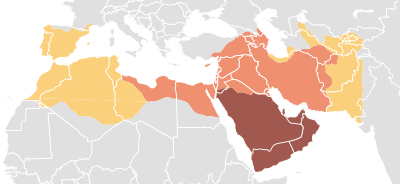 |
|
Main caliphates |
|
Parallel caliphates |
|
|
| Historical Arab states and dynasties | ||||||||||||||||||||||||||||||||||||||||||||||||||||||||||
|---|---|---|---|---|---|---|---|---|---|---|---|---|---|---|---|---|---|---|---|---|---|---|---|---|---|---|---|---|---|---|---|---|---|---|---|---|---|---|---|---|---|---|---|---|---|---|---|---|---|---|---|---|---|---|---|---|---|---|
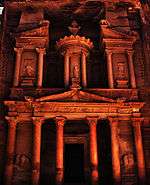 | ||||||||||||||||||||||||||||||||||||||||||||||||||||||||||
|
Ancient Arab States
|
||||||||||||||||||||||||||||||||||||||||||||||||||||||||||
|
Arab Empires
|
||||||||||||||||||||||||||||||||||||||||||||||||||||||||||
|
Eastern Dynasties
|
||||||||||||||||||||||||||||||||||||||||||||||||||||||||||
|
Western Dynasties
|
||||||||||||||||||||||||||||||||||||||||||||||||||||||||||
|
Arabian Peninsula
|
||||||||||||||||||||||||||||||||||||||||||||||||||||||||||
|
East Africa
|
||||||||||||||||||||||||||||||||||||||||||||||||||||||||||
|
Current monarchies
|
||||||||||||||||||||||||||||||||||||||||||||||||||||||||||
Despite this initial cooperation, the Abbasids of the late 8th century had alienated both non-Arab mawali (clients)[4] and Iranian bureaucrats.[5] They were forced to cede authority over al-Andalus (Spain) to the Umayyads in 756, Morocco to the Idrisids in 788, Ifriqiya and Southern Italy to the Aghlabids in 800, Khorasan and Transoxiana to the Samanids and Persia to the Saffarids in the 870s, and Egypt to the Isma'ili-Shia caliphate of the Fatimids in 969.
The political power of the caliphs was limited with the rise of the Iranian Buyids and the Seljuq Turks, who captured Baghdad in 945 and 1055, respectively. Although Abbasid leadership over the vast Islamic empire was gradually reduced to a ceremonial religious function in much of the Caliphate, the dynasty retained control over its Mesopotamian domain. The Abbasids' period of cultural fruition and its (reduced) territorial control ended in 1258 with the sack of Baghdad by the Mongols under Hulagu Khan and the execution of Al-Musta'sim. The Abbasid line of rulers, and Muslim culture in general, re-centred themselves in the Mamluk capital of Cairo in 1261. Though lacking in political power (with the brief exception of Caliph Al-Musta'in of Cairo), the dynasty continued to claim religious authority until after the Ottoman conquest of Egypt in 1517.[6]
History
Abbasid Revolution (750–751)
The Abbasid caliphs were Arabs descended from Abbas ibn Abd al-Muttalib, one of the youngest uncles of Muhammad and of the same Banu Hashim clan. The Abbasids claimed to be the true successors of Prophet Muhammad in replacing the Umayyad descendants of Banu Umayya by virtue of their closer bloodline to Muhammad.
The Abbasids also distinguished themselves from the Umayyads by attacking their moral character and administration in general. According to Ira Lapidus, "The Abbasid revolt was supported largely by Arabs, mainly the aggrieved settlers of Merv with the addition of the Yemeni faction and their Mawali".[7] The Abbasids also appealed to non-Arab Muslims, known as mawali, who remained outside the kinship-based society of the Arabs and were perceived as a lower class within the Umayyad empire. Muhammad ibn 'Ali, a great-grandson of Abbas, began to campaign in Persia for the return of power to the family of Prophet Muhammad, the Hashimites, during the reign of Umar II.
During the reign of Marwan II, this opposition culminated in the rebellion of Ibrahim al-Imam, the fourth in descent from Abbas. Supported by the province of Khorasan (Eastern Persia), even though the governor opposed them, and the Shia Arabs,[2][8] he achieved considerable success, but was captured in the year 747 and died, possibly assassinated, in prison.
On 9 June 747 (15 Ramadan AH 129), Abu Muslim, rising from Khorasan, successfully initiated an open revolt against Umayyad rule, which was carried out under the sign of the Black Standard. Close to 10,000 soldiers were under Abu Muslim's command when the hostilities officially began in Merv.[9] General Qahtaba followed the fleeing governor Nasr ibn Sayyar west defeating the Umayyads at the Battle of Gorgan, the Battle of Nahāvand and finally in the Battle of Karbala, all in the year 748.[8]
.jpg)
The quarrel was taken up by Ibrahim's brother Abdallah, known by the name of Abu al-'Abbas as-Saffah, who defeated the Umayyads in 750 in the battle near the Great Zab and was subsequently proclaimed caliph.[10] After this loss, Marwan fled to Egypt, where he was subsequently assassinated. The remainder of his family, barring one male, were also eliminated.[8]
Immediately after their victory, As-Saffah sent his forces to Central Asia, where his forces fought against Tang expansion during the Battle of Talas. The noble Iranian family Barmakids, who were instrumental in building Baghdad, introduced the world's first recorded paper mill in the city, thus beginning a new era of intellectual rebirth in the Abbasid domain. As-Saffah focused on putting down numerous rebellions in Syria and Mesopotamia. The Byzantines conducted raids during these early distractions.[8]
Power (752–775)
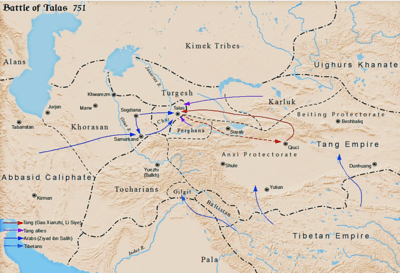
The first change the Abbasids, under Al-Mansur, made was to move the empire's capital from Damascus to a newly founded city, Baghdad, in Iraq, closer to their Persian mawali support base, which addressed its demand for less Arab dominance in the empire. Baghdad was established on the Tigris River in 762. A new position, that of the vizier, was also established to delegate central authority, and even greater authority was delegated to local emirs.[12] Caliph al-Mansur centralised the judicial administration, and later, Harun al-Rashid established the institution of Chief Qadi to oversee it.[13]
This eventually meant that many Abbasid caliphs were relegated to a more ceremonial role than under the Umayyads, as the viziers began to exert greater influence, and the role of the old Arab aristocracy was slowly replaced by a Persian bureaucracy.[12] During Al-Mansur's time control of Al-Andalus was lost, and the Shia revolted and were defeated a year later at the Battle of Bakhamra.[8]
The Abbasids had depended heavily on the support of Persians[2] in their overthrow of the Umayyads. Abu al-'Abbas' successor Al-Mansur welcomed non-Arab Muslims to his court. While this helped integrate Arab and Persian cultures, it alienated many of their Arab supporters, particularly the Khorasanian Arabs who had supported them in their battles against the Umayyads.
These fissures in their support led to immediate problems. The Umayyads, while out of power, were not destroyed. The only surviving member of the Umayyad royal family, which had been all but annihilated, ultimately made his way to Spain where he established himself as an independent Emir (Abd ar-Rahman I, 756). In 929, Abd ar-Rahman III assumed the title of Caliph, establishing Al Andalus from Córdoba as a rival to Baghdad as the legitimate capital of the Islamic Empire.
In the year 755 during the reign of the Abbasid Caliphate in its early stages the people of current day Somalia around Mogadishu and it's environs showed great loyalty to the newly created administration. It is reported that Yahya ibn Umar al Anzi the messenger of the second caliph of the Abbasids Abu Ja'far al-Mansur that the Sultan of Mogadishu and his people swore allegiance to the Caliphate and paid the taxes regularly.
However, in the year 189 A.H. or 804 the people of Mogadishu and the Swahili coast to Kilwa rebelled against the Abbasid rule and administration of Harun al-Rashid and refused to pay the tax. Right after Harun al-Rashid sent a punitive mission to the region to reassert Abbasid control and succeeded in doing so. Abbasid sovereignty was back in the region, although the Sultanate of Mogadishu remained in constant rebellion.
In 829 Al Ma'mun the 7th Caliph of the Abbasids sent an army of 50000 men to crush the secessionist enclaves and add them back to the Caliphate.[14][15]
In 756, the Abbasid Caliph Al-Mansur sent over 4,000 Arab mercenaries to assist the Chinese Tang dynasty in the An Shi Rebellion against An Lushan. The Abbasids or "Black Flags," as they were commonly called, were known in Tang dynasty chronicles as the hēiyī Dàshí, "The Black-robed Tazi", (黑衣大食) ("Tazi" being a borrowing from Persian Tāzī, the word for "Arab").[nb 1][nb 2][nb 3][nb 4][nb 5] Al-Rashid sent embassies to the Chinese Tang dynasty and established good relations with them.[21][nb 6][nb 7][24][25][26][27][28] After the war, these embassies remained in China[29][30][31][32][33] with Caliph Harun al-Rashid establishing an alliance with China.[21] Several embassies from the Abbasid Caliphs to the Chinese court have been recorded in the T'ang Annals, the most important of these being those of Abul Abbas al-Saffah, the first Abbasid caliph, his successor Abu Jafar, and Harun al-Rashid.
Abbasid Golden Age (775–861)
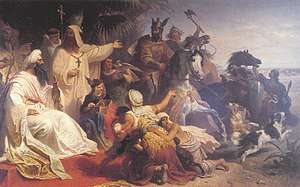
The Abbasid leadership had to work hard in the last half of the 8th century (750–800) under several competent caliphs and their viziers to overcome the political challenges created by the far-flung nature of the empire and the limited communication across it and usher in the administrative changes needed to keep order.[34] It was also during this early period of the dynasty, in particular during the governance of al-Mansur, Harun al-Rashid, and al-Ma'mun, that the reputation and power of the dynasty was created.[2]
Al-Mahdi restarted the fighting with the Byzantines and his sons continued the conflict until Empress Irene pushed for peace.[8] After several years of peace, Nikephoros I broke the treaty, then fended off multiple incursions during the first decade of the 9th century. These attacks pushed into the Taurus Mountains culminating with a victory at the Battle of Krasos and the massive invasion of 806, led by Rashid himself.[35]
Rashid's navy also proved successful, taking Cyprus. Rashid decided to focus on the rebellion of Rafi ibn al-Layth in Khorasan and died while there.[35] While the Byzantine Empire was fighting Abbasid rule in Syria and Anatolia, military operations during this period were minimal, as the caliphate focused on internal matters, its governors exerting greater autonomy and using their increasing power to make their positions hereditary.[12]
At the same time, the Abbasids faced challenges closer to home. Harun al-Rashid turned on the Barmakids, a Persian family that had grown significantly in power within the administration of the state and killed most of the family.[36] During the same period, several factions began either to leave the empire for other lands or to take control of distant parts of the empire away from the Abbasids. The reigns of al-Rashid and his sons were considered to be the apex of the Abbasids.[37]
.jpg)
After Rashid's death, the empire was split by a civil war between the caliph al-Amin and his brother al-Ma'mun who had the support of Khorasan. This war ended with a two-year siege of Baghdad and the eventual death of al-Amin in 813.[35] Al-Ma'mun ruled for 20 years of relative calm interspersed with a rebellion supported by the Byzantines in Azerbaijan by the Khurramites. Al-Ma'mun was also responsible for the creation of an autonomous Khorasan, and the continued repulsing of Byzantine forays.[35]
Al-Mu'tasim gained power in 833 and his rule marked the end of the strong caliphs. He strengthened his personal army with Turkish mercenaries and promptly restarted the war with the Byzantines. His military excursions were generally successful, culminating with a resounding victory in the Sack of Amorium. His attempt to seize Constantinople failed when his fleet was destroyed by a storm.[38] The Byzantines restarted the fighting by sacking Damietta in Egypt. Al-Mutawakkil responded by sending his troops into Anatolia again, sacking and marauding until they were eventually annihilated in 863.[39]
Fracture to autonomous dynasties (861–945)
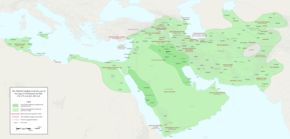
Even by 820, the Samanids had begun the process of exercising independent authority in Transoxiana and Greater Khorasan, and the succeeding Tahirid and Saffarid dynasties of Iran. The Saffarids, from Khorasan, nearly seized Baghdad in 876, and the Tulunids took control of most of Syria. The trend of weakening of the central power and strengthening of the minor caliphates on the periphery continued.[37]
An exception was the 10-year period of Al-Mu'tadid's rule (892–902). He brought parts of Egypt, Syria, and Khorasan back into Abbasid control. Especially after the "Anarchy at Samarra" (861–870), the Abbasid central government was weakened and centrifugal tendencies became more prominent in the Caliphate's provinces. By the early 10th century, the Abbasids almost lost control of Iraq to various amirs, and the caliph al-Radi was forced to acknowledge their power by creating the position of "Prince of Princes" (amir al-umara).[37]
Al-Mustakfi had a short reign from 944–946, and it was during this period that the Persian faction known as the Buyids from Daylam swept into power and assumed control over the bureaucracy in Baghdad. According to the history of Miskawayh, they began distributing iqtas (fiefs in the form of tax farms) to their supporters. This period of localized secular control was to last nearly 100 years.[2] The loss of Abbasid power to the Buyids would shift as the Seljuks would take over from the Persians.[37]
At the end of the eighth century, the Abbasids found they could no longer keep together a huge polity, larger than that of Rome, from Baghdad. In 793 the Zaydi-Shia dynasty of Idrisids set up a state from Fez in Morocco, while a family of governors under the Abbasids became increasingly independent until they founded the Aghlabid Emirate from the 830s. Al-Mu'tasim started the downward slide by utilizing non-Muslim mercenaries in his personal army. Also during this period officers started assassinating superiors with whom they disagreed, in particular the caliphs.[2]
By the 870s, Egypt became autonomous under Ahmad ibn Tulun. In the East as well, governors decreased their ties to the center. The Saffarids of Herat and the Samanids of Bukhara had broken away from the 870s, cultivating a much more Persianate culture and statecraft. By this time only the central lands of Mesopotamia were under direct Abbasid control, with Palestine and the Hijaz often managed by the Tulunids. Byzantium, for its part, had begun to push Arab Muslims farther east in Anatolia.
By the 920s, the situation had changed further, as North Africa was lost to the Abbasids. A Shia sect only recognizing the first five Imams and tracing its roots to Muhammad's daughter Fatima took control of Idrisid and then Aghlabid domains.[37] Called the Fatimid dynasty, they had advanced to Egypt in 969, establishing their capital near Fustat in Cairo, which they built as a bastion of Shia learning and politics. By 1000 they had become the chief political and ideological challenge to Sunni Islam in the form of the Abbasids. By this time the latter state had fragmented into several governorships that, while recognizing caliphal authority from Baghdad, did mostly as they wanted, fighting with each other. The Caliph himself was under 'protection' of the Buyid Emirs who possessed all of Iraq and western Iran, and were quietly Shia in their sympathies.
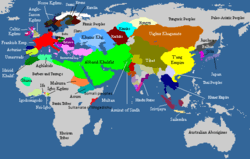
Outside Iraq, all the autonomous provinces slowly took on the characteristic of de facto states with hereditary rulers, armies, and revenues and operated under only nominal caliph suzerainty, which may not necessarily be reflected by any contribution to the treasury, such as the Soomro Emirs that had gained control of Sindh and ruled the entire province from their capital of Mansura.[34] Mahmud of Ghazni took the title of sultan, as opposed to the "amir" that had been in more common usage, signifying the Ghaznavid Empire's independence from caliphal authority, despite Mahmud's ostentatious displays of Sunni orthodoxy and ritual submission to the caliph. In the 11th century, the loss of respect for the caliphs continued, as some Islamic rulers no longer mentioned the caliph's name in the Friday khutba, or struck it off their coinage.[34]
The Isma'ili Fatimid dynasty of Cairo contested the Abbasids for even the titular authority of the Islamic ummah. They commanded some support in the Shia sections of Baghdad (such as Karkh), although Baghdad was the city most closely connected to the caliphate, even in the Buyid and Seljuq eras. The Fatimids' green banners contrasted with Abbasids' black, and the challenge of the Fatimids only ended with their downfall in the 12th century.
Buyid and Seljuq control (945–1118)
Despite the power of the Buyid amirs, the Abbasids retained a highly ritualized court in Baghdad, as described by the Buyid bureaucrat Hilal al-Sabi', and they retained a certain influence over Baghdad as well as religious life. As Buyid power waned with the rule of Baha' al-Daula, the caliphate was able to regain some measure of strength. The caliph al-Qadir, for example, led the ideological struggle against the Shia with writings such as the Baghdad Manifesto. The caliphs kept order in Baghdad itself, attempting to prevent the outbreak of fitnas in the capital, often contending with the ayyarun.
With the Buyid dynasty on the wane, a vacuum was created that was eventually filled by the dynasty of Oghuz Turks known as the Seljuqs. By 1055, the Seljuqs had wrested control from the Buyids and Abbasids, and took any remaining temporal power.[2] When the amir and former slave Basasiri took up the Shia Fatimid banner in Baghdad in 1056–57, the caliph al-Qa'im was unable to defeat him without outside help. Toghril Beg, the Seljuq sultan, restored Baghdad to Sunni rule and took Iraq for his dynasty.
Once again, the Abbasids were forced to deal with a military power that they could not match, though the Abbasid caliph remained the titular head of the Islamic community. The succeeding sultans Alp Arslan and Malikshah, as well as their vizier Nizam al-Mulk, took up residence in Persia, but held power over the Abbasids in Baghdad. When the dynasty began to weaken in the 12th century, the Abbasids gained greater independence once again.
Revival of military strength (1118–1258)
While the Caliph al-Mustarshid was the first caliph to build an army capable of meeting a Seljuk army in battle, he was nonetheless defeated in 1135 and assassinated. The Caliph al-Muqtafi was the first Abbasid Caliph to regain the full military independence of the Caliphate, with the help of his vizier Ibn Hubayra. After nearly 250 years of subjection to foreign dynasties, he successfully defended Baghdad against the Seljuqs in the siege of Baghdad (1157), thus securing Iraq for the Abbasids. The reign of al-Nasir (d. 1225) brought the caliphate back into power throughout Iraq, based in large part on the Sufi futuwwa organizations that the caliph headed.[37] Al-Mustansir built the Mustansiriya School, in an attempt to eclipse the Seljuq-era Nizamiyya built by Nizam al Mulk.
Mongol invasion (1206–1258)

In 1206, Genghis Khan established a powerful dynasty among the Mongols of central Asia. During the 13th century, this Mongol Empire conquered most of the Eurasian land mass, including both China in the east and much of the old Islamic caliphate (as well as Kievan Rus') in the west. Hulagu Khan's destruction of Baghdad in 1258 is traditionally seen as the approximate end of the Golden Age.[40] Mongols feared that a supernatural disaster would strike if the blood of Al-Musta'sim, a direct descendant of Muhammad's uncle Abbas ibn Abd al-Muttalib,[41] and the last reigning Abbasid caliph in Baghdad, was spilled. The Shia of Persia stated that no such calamity had happened after the death of Husayn ibn Ali in the Battle of Kerbala; nevertheless, as a precaution and in accordance with a Mongol taboo which forbade spilling royal blood, Hulagu had Al-Musta'sim wrapped in a carpet and trampled to death by horses on 20 February 1258. The Caliph's immediate family was also executed, with the lone exceptions of his youngest son who was sent to Mongolia, and a daughter who became a slave in the harem of Hulagu.[42]
Abbasid Caliphate of Cairo (1261–1517)
In the 9th century, the Abbasids created an army loyal only to their caliphate, composed of non-Arab origin people, known as Mamluks.[43][44][45][46][47] This force, created in the reign of al-Ma'mun (813–833) and his brother and successor al-Mu'tasim (833–842), prevented the further disintegration of the empire. The Mamluk army, though often viewed negatively, both helped and hurt the caliphate. Early on, it provided the government with a stable force to address domestic and foreign problems. However, creation of this foreign army and al-Mu'tasim's transfer of the capital from Baghdad to Samarra created a division between the caliphate and the peoples they claimed to rule. In addition, the power of the Mamluks steadily grew until al-Radi (934–941) was constrained to hand over most of the royal functions to Muhammad ibn Ra'iq.[10]
The Mamluks eventually came to power in Egypt. In 1261, following the devastation of Baghdad by the Mongols, the Mamluk rulers of Egypt re-established the Abbasid caliphate in Cairo. The first Abbasid caliph of Cairo was Al-Mustansir. The Abbasid caliphs in Egypt continued to maintain the presence of authority, but it was confined to religious matters. The Abbasid caliphate of Cairo lasted until the time of Al-Mutawakkil III, who was taken away as a prisoner by Selim I to Constantinople where he had a ceremonial role. He died in 1543, following his return to Cairo.
Culture
Islamic Golden Age
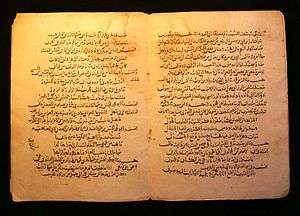
The Abbasid historical period lasting to the Mongol conquest of Baghdad in 1258 CE is considered the Islamic Golden Age.[48] The Islamic Golden Age was inaugurated by the middle of the 8th century by the ascension of the Abbasid Caliphate and the transfer of the capital from Damascus to Baghdad.[49] The Abbassids were influenced by the Qur'anic injunctions and hadith, such as "the ink of a scholar is more holy than the blood of a martyr", stressing the value of knowledge. During this period the Muslim world became an intellectual center for science, philosophy, medicine and education as[49] the Abbasids championed the cause of knowledge and established the House of Wisdom in Baghdad, where both Muslim and non-Muslim scholars sought to translate and gather all the world's knowledge into Arabic.[49] Many classic works of antiquity that would otherwise have been lost were translated into Arabic and Persian and later in turn translated into Turkish, Hebrew and Latin.[49] During this period the Muslim world was a cauldron of cultures which collected, synthesized and significantly advanced the knowledge gained from the Roman, Chinese, Indian, Persian, Egyptian, North African, Ancient Greek and Medieval Greek civilizations.[49] According to Huff, "[i]n virtually every field of endeavor—in astronomy, alchemy, mathematics, medicine, optics and so forth—the Caliphate's scientists were in the forefront of scientific advance."[50]
Science
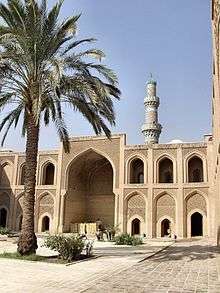
The reigns of Harun al-Rashid (786–809) and his successors fostered an age of great intellectual achievement. In large part, this was the result of the schismatic forces that had undermined the Umayyad regime, which relied on the assertion of the superiority of Arab culture as part of its claim to legitimacy, and the Abbasids' welcoming of support from non-Arab Muslims. It is well established that the Abbasid caliphs modeled their administration on that of the Sassanids.[51] Harun al-Rashid's son, Al-Ma'mun (whose mother was Persian), is even quoted as saying:
The Persians ruled for a thousand years and did not need us Arabs even for a day. We have been ruling them for one or two centuries and cannot do without them for an hour.[52]
A number of medieval thinkers and scientists living under Islamic rule played a role in transmitting Islamic science to the Christian West. In addition, the period saw the recovery of much of the Alexandrian mathematical, geometric and astronomical knowledge, such as that of Euclid and Claudius Ptolemy. These recovered mathematical methods were later enhanced and developed by other Islamic scholars, notably by Persian scientists Al-Biruni and Abu Nasr Mansur.
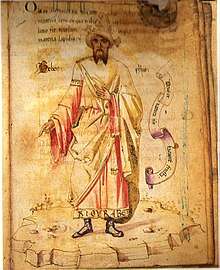
Christians (particularly Nestorian Christians) contributed to the Arab Islamic Civilization during the Ummayads and the Abbasids by translating works of Greek philosophers to Syriac and afterwards to Arabic.[55][56] Nestorians played a prominent role in the formation of Arab culture,[57] with the Academy of Gondishapur being prominent in the late Sassanid, Umayyad and early Abbasid periods.[58] Notably, eight generations of the Nestorian Bukhtishu family served as private doctors to caliphs and sultans between the eighth and eleventh centuries.[59][60]
Algebra was significantly developed by Persian scientist Muhammad ibn Mūsā al-Khwārizmī during this time in his landmark text, Kitab al-Jabr wa-l-Muqabala, from which the term algebra is derived. He is thus considered to be the father of algebra by some,[61] although the Greek mathematician Diophantus has also been given this title. The terms algorism and algorithm are derived from the name of al-Khwarizmi, who was also responsible for introducing the Arabic numerals and Hindu-Arabic numeral system beyond the Indian subcontinent.
Arab scientist Ibn al-Haytham (Alhazen) developed an early scientific method in his Book of Optics (1021). The most important development of the scientific method was the use of experiments to distinguish between competing scientific theories set within a generally empirical orientation, which began among Muslim scientists. Ibn al-Haytham's empirical proof of the intromission theory of light (that is, that light rays entered the eyes rather than being emitted by them) was particularly important. Alhazen was significant in the history of scientific method, particularly in his approach to experimentation,[63] and has been referred to as the "world's first true scientist".[64]
Medicine in medieval Islam was an area of science that advanced particularly during the Abbasids' reign. During the 9th century, Baghdad contained over 800 doctors, and great discoveries in the understanding of anatomy and diseases were made. The clinical distinction between measles and smallpox was described during this time. Famous Persian scientist Ibn Sina (known to the West as Avicenna) produced treatises and works that summarized the vast amount of knowledge that scientists had accumulated, and was very influential through his encyclopedias, The Canon of Medicine and The Book of Healing. The work of him and many others directly influenced the research of European scientists during the Renaissance.
Astronomy in medieval Islam was advanced by Al-Battani, who improved the precision of the measurement of the precession of the Earth's axis. The corrections made to the geocentric model by al-Battani, Averroes, Nasir al-Din al-Tusi, Mo'ayyeduddin Urdi and Ibn al-Shatir were later incorporated into the Copernican heliocentric model.[65] The astrolabe, though originally developed by the Greeks, was developed further by Islamic astronomers and engineers, and subsequently brought to medieval Europe.
Muslim alchemists influenced medieval European alchemists, particularly the writings attributed to Jābir ibn Hayyān (Geber). A number of chemical processes such as distillation techniques were developed in the Muslim world and then spread to Europe.
Literature
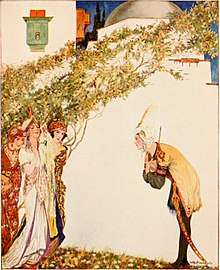
The best known fiction from the Islamic world is The Book of One Thousand and One Nights, a collection of fantastical folk tales, legends and parables compiled primarily during the Abbassid era. The collection is recorded as having originated from an Arabic translation of a Sassanian era Persian prototype, with likely origins in Indian literary traditions. Stories from Arabic, Persian, Mesopotamian, and Egyptian folklore and literature were later incorporated. The epic is believed to have taken shape in the 10th century and reached its final form by the 14th century; the number and type of tales have varied from one manuscript to another.[66] All Arabian fantasy tales were often called "Arabian Nights" when translated into English, regardless of whether they appeared in The Book of One Thousand and One Nights.[66] This epic has been influential in the West since it was translated in the 18th century, first by Antoine Galland.[67] Many imitations were written, especially in France.[68] Various characters from this epic have themselves become cultural icons in Western culture, such as Aladdin, Sinbad and Ali Baba.
A famous example of Islamic poetry on romance was Layla and Majnun, an originally Arabic story which was further developed by Iranian, Azerbaijani and other poets in the Persian, Azerbaijani, and Turkish languages.[69] It is a tragic story of undying love much like the later Romeo and Juliet.
Arabic poetry reached its greatest height in the Abbasid era, especially before the loss of central authority and the rise of the Persianate dynasties. Writers like Abu Tammam and Abu Nuwas were closely connected to the caliphal court in Baghdad during the early 9th century, while others such as al-Mutanabbi received their patronage from regional courts.
Philosophy
One of the common definitions for "Islamic philosophy" is "the style of philosophy produced within the framework of Islamic culture."[70] Islamic philosophy, in this definition is neither necessarily concerned with religious issues, nor is exclusively produced by Muslims.[70] Their works on Aristotle were a key step in the transmission of learning from ancient Greeks to the Islamic world and the West. They often corrected the philosopher, encouraging a lively debate in the spirit of ijtihad. They also wrote influential original philosophical works, and their thinking was incorporated into Christian philosophy during the Middle Ages, notably by Thomas Aquinas.[71]
Three speculative thinkers, al-Kindi, al-Farabi, and Avicenna, combined Aristotelianism and Neoplatonism with other ideas introduced through Islam, and Avicennism was later established as a result. Other influential Abbasid philosophers include al-Jahiz, and Ibn al-Haytham (Alhacen).
Architecture
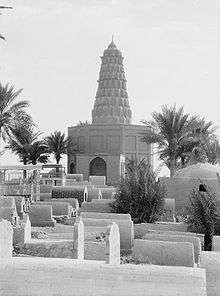
As power shifted from the Umayyads to the Abbasids, the architectural styles changed also. The Christian styles evolved into a style based more on the Sasanian Empire, utilizing mud bricks and baked bricks with carved stucco.[72] Another major development was the creation or vast enlargement of cities as they were turned into the capital of the empire, beginning with the creation of Baghdad in 762, which was planned as a walled city with four gates, and a mosque and palace in the center. Al-Mansur, who was responsible for the creation of Baghdad, also planned the city of Raqqa, along the Euphrates. Finally, in 836, al-Mu'tasim moved the capital to a new site that he created along the Tigris, called Samarra. This city saw 60 years of work, with race-courses and game preserves to add to the atmosphere.[72] Due to the dry remote nature of the environment, some of the palaces built in this era were isolated havens. Al-Ukhaidir Fortress is a fine example of this type of building, which has stables, living quarters, and a mosque, all surrounding inner courtyards.[72] Other mosques of this era, such as the Mosque of Ibn Tulun, in Cairo, and the Great Mosque of Kairouan in Tunisia, while ultimately built during the Umayyad dynasty, were substantially renovated in the 9th century. These renovations, so extensive as to ostensibly be rebuilds, were in the furthest reaches of the Muslim world, in an area that the Aghlabids controlled; however, the styles utilized were mainly Abbasid.[73] Mesopotamia only has one surviving mausoleum from this era, in Samarra. This octagonal dome is the final resting place of al-Muntasir.[74] Other architectural innovations and styles were few, such as the four-centered arch, and a dome erected on squinches. Unfortunately, much was lost due to the ephemeral nature of the stucco and luster tiles.[74]
Foundation of Baghdad
The Caliph al-Mansur founded the epicenter of the empire, Baghdad, in 762 CE, as a means of disassociating his dynasty from that of the preceding Umayyads (centered at Damascus) and the rebellious cities of Kufa and Basrah. Mesopotamia was an ideal locale for a capital city due to its high agricultural output, access to the Euphrates and Tigris Rivers (allowing for trade and communication across the region), central locale between the corners of the vast empire (stretching from Egypt to Afghanistan) and access to the Silk Road and Indian Ocean trade routes, all key reasons as to why the region has hosted important capital cities such as Ur, Babylon, Nineveh and Ctesiphon and was later desired by the British Empire as an outpost by which to maintain access to India.[75] The city was organized in a circular fashion next to the Tigris River, with massive brick walls being constructed in successive rings around the core by a workforce of 100,000 with four huge gates (named Kufa, Basrah, Khorasan and Syria). The central enclosure of the city contained Mansur's palace of 360,000 square feet (33,000 m2) in area and the great mosque of Baghdad, encompassing 90,000 square feet (8,400 m2). Travel across the Tigris and the network of waterways allowing the drainage of the Euphrates into the Tigris was facilitated by bridges and canals servicing the population.[76]
Glass and crystal
The Near East has, since Roman times, been recognized as a center of quality glassware and crystal. 9th-century finds from Samarra show styles similar to Sassanian forms. The types of objects made were bottles, flasks, vases, and cups intended for domestic use, with decorations including molded flutes, honeycomb patterns, and inscriptions.[77] Other styles seen that may not have come from the Sassanians were stamped items. These were typically round stamps, such as medallions or disks with animals, birds, or Kufic inscriptions. Colored lead glass, typically blue or green, has been found in Nishapur, along with prismatic perfume bottles. Finally, cut glass may have been the high point of Abbasid glass-working, decorated with floral and animal designs.[78]
Painting
Early Abbasid painting has not survived in great quantities, and is sometimes harder to differentiate; however, Samarra provides good examples, as it was built by the Abbasids and abandoned 56 years later. The walls of the principal rooms of the palace that have been excavated show wall paintings and lively carved stucco dadoes. The style is obviously adopted with little variation from Sassanian art, bearing not only similar styles, with harems, animals, and dancing people, all enclosed in scrollwork, but the garments are also Persian.[79] Nishapur had its own school of painting. Excavations at Nishapur show both monochromatic and polychromatic artwork from the 8th and 9th centuries. One famous piece of art consists of hunting nobles with falcons and on horseback, in full regalia; the clothing identifies them as Tahirid, which was, again, a sub-dynasty of the Abbasids. Other styles are of vegetation, and fruit in nice colors on a four-foot high dedo.[79]
Pottery
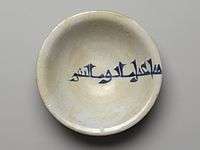
Whereas painting and architecture were not areas of strength for the Abbasid dynasty, pottery was a different story. Islamic culture as a whole, and the Abbasids in particular, were at the forefront of new ideas and techniques. Some examples of their work were pieces engraved with decorations and then colored with yellow-brown, green, and purple glazes. Designs were diverse with geometric patterns, Kufic lettering, and arabesque scrollwork, along with rosettes, animals, birds, and humans.[80] Abbasid pottery from the 8th and 9th centuries has been found throughout the region, as far as Cairo. These were generally made with a yellow clay and fired multiple times with separate glazes to produce metallic luster in shades of gold, brown, or red. By the 9th century, the potters had mastered their techniques and their decorative designs could be divided into two styles. The Persian style would show animals, birds, and humans, along with Kufic lettering in gold. Pieces excavated from Samarra exceed in vibrancy and beauty any from later periods. These predominantly being made for the Caliphs use. Tiles were also made using this same technique to create both monochromatic and polychromatic lusterware tiles.[81]
Textiles
Egypt being a center of the textile industry was part of Abbasid cultural advancement. Copts were employed in the textile industry and produced linens and silks. Tinnis was famous for its factories and had over 5,000 looms. Examples of textiles were kasab, a fine linen for turbans, and badana for upper-class garments. The kiswah for the kaaba in Mecca was made in a town named Tuna near Tinnis. Fine silk was also made in Dabik and Damietta.[82] Of particular interest are stamped and inscribed fabrics, which used not only inks but also liquid gold. Some of the finer pieces were colored in such a manner as to require six separate stamps to achieve the proper design and color. This technology spread to Europe eventually.[83]
Technology
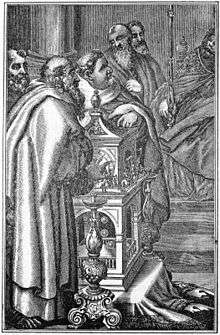
In technology, the Abbasids adopted papermaking from China.[84] The use of paper spread from China into the caliphate in the 8th century CE, arriving in al-Andalus (Islamic Spain) and then the rest of Europe in the 10th century. It was easier to manufacture than parchment, less likely to crack than papyrus, and could absorb ink, making it ideal for making records and copies of the Qur'an. "Islamic paper makers devised assembly-line methods of hand-copying manuscripts to turn out editions far larger than any available in Europe for centuries."[85] It was from the Abbasids that the rest of the world learned to make paper from linen.[86] The knowledge of gunpowder was also transmitted from China via the caliphate, where the formulas for pure potassium nitrate and an explosive gunpowder effect were first developed.[87]
Advances were made in irrigation and farming, using new technology such as the windmill. Crops such as almonds and citrus fruit were brought to Europe through al-Andalus, and sugar cultivation was gradually adopted by the Europeans. Apart from the Nile, Tigris and Euphrates, navigable rivers were uncommon, so transport by sea was very important. Navigational sciences were highly developed, making use of a rudimentary sextant (known as a kamal). When combined with detailed maps of the period, sailors were able to sail across oceans rather than skirt along the coast. Abbasid sailors were also responsible for reintroducing large three masted merchant vessels to the Mediterranean. The name caravel may derive from an earlier Arab ship known as the qārib.[88] Arab merchants dominated trade in the Indian Ocean until the arrival of the Portuguese in the 16th century. Hormuz was an important center for this trade. There was also a dense network of trade routes in the Mediterranean, along which Muslim countries traded with each other and with European powers such as Venice or Genoa. The Silk Road crossing Central Asia passed through the Abbasid caliphate between China and Europe.
Engineers in the Abbasid caliphate made a number of innovative industrial uses of hydropower, and early industrial uses of tidal power, wind power, and petroleum (notably by distillation into kerosene). The industrial uses of watermills in the Islamic world date back to the 7th century, while horizontal-wheeled and vertical-wheeled water mills were both in widespread use since at least the 9th century. By the time of the Crusades, every province throughout the Islamic world had mills in operation, from al-Andalus and North Africa to the Middle East and Central Asia. These mills performed a variety of agricultural and industrial tasks.[84] Abbasid engineers also developed machines (such as pumps) incorporating crankshafts, employed gears in mills and water-raising machines, and used dams to provide additional power to watermills and water-raising machines.[90] Such advances made it possible for many industrial tasks that were previously driven by manual labour in ancient times to be mechanized and driven by machinery instead in the medieval Islamic world. It has been argued that the industrial use of waterpower had spread from Islamic to Christian Spain, where fulling mills, paper mills, and forge mills were recorded for the first time in Catalonia.[91]
A number of industries were generated during the Arab Agricultural Revolution, including early industries for textiles, sugar, rope-making, matting, silk, and paper. Latin translations of the 12th century passed on knowledge of chemistry and instrument making in particular.[92] The agricultural and handicraft industries also experienced high levels of growth during this period.[93]
Status of women
In contrast to the earlier era, women in Abbasid society were absent from all arenas of the community's central affairs.[94] While their Muslim forbears led men into battle, started rebellions, and played an active role in community life, as demonstrated in the Hadith literature, Abbasid women were ideally kept in seclusion. Conquests had brought enormous wealth and large numbers of slaves to the Muslim elite. The majority of the slaves were women and children,[95] many of whom had been dependents or harem-members of the defeated Sassanian upper classes.[96] In the wake of the conquests an elite man could potentially own a thousand slaves, and ordinary soldiers could have ten people serving them.[95]
Nabia Abbott, preeminent historian of elite women of the Abbasid Caliphate, describes the lives of harem women as follows.
The choicest women were imprisoned behind heavy curtains and locked doors, the strings and keys of which were entrusted into the hands of that pitiable creature – the eunuch. As the size of the harem grew, men indulged to satiety. Satiety within the individual harem meant boredom for the one man and neglect for the many women. Under these conditions ... satisfaction by perverse and unnatural means crept into society, particularly in its upper classes.[96]
The marketing of human beings, particularly women, as objects for sexual use meant that elite men owned the vast majority of women they interacted with, and related to them as would masters to slaves.[97] Being a slave meant relative lack of autonomy during this time period, and belonging to a harem caused a wife and her children to have little insurance of stability and continued support due to the volatile politics of harem life.
Elite men expressed in literature the horror they felt for the humiliation and degradation of their daughters and female relatives. For example, the verses addressed to Hasan ibn al-Firat on the death of his daughter read:
To Abu Hassan I offer condolences.
At times of disaster and catastrophe
God multiplies rewards for the patient.
To be patient in misery
Is equivalent to giving thanks for a gift.
Among the blessings of God undoubtedly
Is the preservation of sons
And the death of daughters.[98]
Even so, courtesans and princesses produced prestigious and important poetry. Enough survives to give us access to women's historical experiences, and reveals some vivacious and powerful figures, such as the Sufi mystic Raabi'a al-Adwiyya (714–801 CE), the princess and poet 'Ulayya bint al-Mahdi (777–825 CE), and the singing-girls Shāriyah (c. 815–870 CE), Fadl Ashsha'ira (d. 871 CE) and Arib al-Ma'muniyya (797–890 CE).[99]
Treatment of Jews and Christians
The status and treatment of Jews, Christians, and non-Muslims in the Abbasid Caliphate was a complex and continually changing issue. Non-Muslims were called dhimmis.[100] Dhimmis did not have all of the privileges that Muslims had and commonly had to pay jizya, a tax for not being a Muslim. One of the common aspects of the treatment of the dhimmis is that their treatment depended on who the Caliph was at the time. Some Abbasid rulers, like Al-Mutawakkil (822–861 CE) imposed strict restrictions on what dhimmis could wear in public, often yellow garments that distinguished them from Muslims.[101] Other restrictions al-Mutawakkil imposed included limiting the role of the dhimmis in government, seizing dhimmi housing and making it harder for dhimmis to become educated.[101] Most other Abbasid caliphs were not as strict as al-Mutawakkil, though. During the reign of Al-Mansur (714–775 CE), it was common for Jews and Christians to influence the overall culture in the Caliphate, specifically in Baghdad. Jews and Christians did this by participating in scholarly work and Christians even influenced Islamic funeral service traditions.[100]
It was common that laws that were imposed against dhimmis during one caliph's rule were either discarded or not practiced during future caliphs' reigns. Al-Mansur and al-Mutawakkil both instituted laws that forbade non-Muslims from participating in public office.[102] Al-Mansur did not follow his own law very closely, bringing dhimmis back to the Caliphate's treasury due to the needed expertise of dhimmis in the area of finance.[103] Al-Mutawakkil followed the law banning dhimmis from public office more seriously, although, soon after his reign, many of the laws concerning dhimmis participating in government were completely unobserved or at least less strictly observed.[101] Even Al-Muqtadir (r. 908–932 CE), who held a similar stance as al-Mutawakkil on barring non-Muslims from public office, himself had multiple Christian secretaries, indicating that non-Muslims still had access to many of the most important figures within the Caliphate.[103] Past having a casual association or just being a secretary to high-ranking Islamic officials, many Caliphs like Al-Mansur would personally appoint dhimmis to important positions of power, like collector of revenue.
Jews and Christians may have had a lower overall status compared to Muslims in the Abbasid Caliphate, but dhimmis were often allowed to hold respectable and even prestigious occupations in some cases, such as doctors and public officeholders. Jews and Christians were also allowed to be rich even if they were taxed for being a dhimmi.[100] Dhimmis were capable of moving up and down the social ladder, though this largely depended on the particular caliph. An indication as to the social standing of Jews and Christians at the time was their ability to live next to Muslim people. While al-Mansur was ruling the Caliphate, for instance, it was not uncommon for dhimmis to live in the same neighborhoods as Muslims.[100] One of the biggest reasons why dhimmis were allowed to hold prestigious jobs and positions in government is that they were generally important to the well-being of the state and were proficient to excellent with the work at hand.[104] Some Muslims in the Caliphate took offense to the idea that there were dhimmis in public offices who were in a way ruling over them although it was an Islamic state, while other Muslims were at time jealous of some dhimmis for having a level of wealth or prestige greater than other Muslims, even if Muslims were still the majority of the ruling class.[103] In general, Muslims, Jews, and Christians had close relations that could be considered positive at times, especially for Jews, in contrast to how Jews were being treated in Europe.[100]
Many of the laws and restrictions that were imposed on dhimmis often resembled other laws that previous states had used to discriminate against a minority religion, specifically Jewish people. Romans in the fourth century banned Jewish people from holding public offices, banned Roman citizens from converting to Judaism, and often demoted Jews who were serving in the Roman military.[105] In direct contrast, there was an event in which two viziers, Ibn al-Furat and Ali ibn Isa ibn al-Jarrah, argued about Ibn al-Furat's decision to make a Christian the head of the military. A previous vizier, Abu Muhammad al-Hasan al-Bazuri, had done so. These laws predated al-Mansur's laws against dhimmis and often had similar restrictions, although Roman emperors were often much more strict on enforcing these laws than many Abbasid caliphs.[106]
Arabization
While the Abbasids originally gained power by exploiting the social inequalities against non-Arabs in the Umayyad Empire, during Abbasid rule the empire rapidly Arabized, particularly in the Fertile Crescent region (namely Mesopotamia and the Levant) as had begun under Umayyad rule. As knowledge was shared in the Arabic language throughout the empire, many people from different nationalities and religions began to speak Arabic in their everyday lives. Resources from other languages began to be translated into Arabic, and a unique Islamic identity began to form that fused previous cultures with Arab culture, creating a level of civilization and knowledge that was considered a marvel in Europe at the time.[107]
Military
In Baghdad there were many Abbasid military leaders who were or said they were of Arab descent. However, it is clear that most of the ranks were of Iranian origin, the vast majority being from Khorasan and Transoxiana, not from western Iran or Azerbaijan.[108] Most of the Khorasani soldiers who brought the Abbasids to power were Arabs.[109]
The standing army of the Muslims in Khorosan was overwhelmingly Arab. The unit organization of the Abbasids was designed with the goal of ethnic and racial equality among supporters. When Abu Muslim recruited officers along the Silk Road, he registered them based not on their tribal or ethno-national affiliations but on their current places of residence.[110]
Decline of the empire
Abbasids found themselves at odds with the Shia Muslims, most of whom had supported their war against the Umayyads, since the Abbasids and the Shias claimed legitimacy by their familial connection to Prophet Muhammad; once in power, the Abbasids disavowed any support for Shia beliefs in favor of Sunni Islam. Shortly thereafter, Berber Kharijites set up an independent state in North Africa in 801. Within 50 years the Idrisids in the Maghreb and Aghlabids of Ifriqiya and a little later the Tulunids and Ikshidids of Misr were effectively independent in Africa. The Abbasid authority began to deteriorate during the reign of al-Radi when their Turkic Army generals, who already had de facto independence, stopped paying the Caliphate. Even provinces close to Baghdad began to seek local dynastic rule. Also, the Abbasids found themselves to often be at conflict with the Umayyads in Spain. The Abbasid financial position weakened as well, with tax revenues from the Sawād decreasing in the 9th and 10th centuries.[111]
Separatist dynasties and their successors
The Abbasid Caliphate differed from others in that it did not have the same borders and extent as Islam. Particularly, in the west of the Caliphate, there were multiple smaller caliphates that existed in relative peace with them.[2] This list represents the succession of Islamic dynasties that emerged from the fractured Abbasid empire by their general geographic location. Dynasties often overlap, where a vassal emir revolted from and later conquered his lord. Gaps appear during periods of contest where the dominating power was unclear. Except for the Fatimid Caliphate in Egypt, recognizing a Shia succession through Ali, and the Andalusian Caliphates of the Umayyads and Almohads, every Muslim dynasty at least acknowledged the nominal suzerainty of the Abbasids as Caliph and Commander of the Faithful.
- Morocco: Idrisids (788–974) → Almoravids (1040–1147) → Almohads (1120–1269) → Marinids (1472–1554) → Wattasids (1472–1554)
- Ifriqiya (modern Tunisia, eastern Algeria and western Libya): Aghlabids (800–909 CE) → Fatimids of Egypt (909–973 CE) → Zirids (973–1148) → Almohads (1148–1229) → Hafsids (1229–1574)
- Egypt and Palestine: Tulunids (868–905 CE) → Ikhshidids (935–969) → Fatimid Caliphate (909–1171) → Ayyubid dynasty (1171–1250) → Mamluks (1250–1517)
- Al-Jazira (modern Syria and northern Iraq): Hamdanids (890–1004 CE) → Marwanids (990–1085) and Uqaylids (990–1096) → Seljuks (1034–1194) → Mongol Empire and the Ilkhanate (1231–1335)
- Southwest Iran: Buyids (934–1055) → Seljuks (1034–1194) → Mongol Empire → Injuids (1335–1357) → Muzaffarids (1314–1393)
- Khorasan (modern Iran, Afghanistan and Turkmenistan): Tahirids (821–873) → Saffarids (873–903) → Samanids (903–995) → Ghaznavids (995–1038) → Seljuks (1038–1194) → Ghurids (1011–1215) → Khwarazmians (1077–1231) → Mongol Empire and the Ilkhanate (1231–1335)
- Transoxiana (modern Central Asia): Samanids (819–999) → Karakhanids (840–1212) → Khwarazmians (1077–1231) → Mongol Empire and the Chagatai Khanate (1225–1687)
Dynasties claiming Abbasid descent
Centuries after the Abbasids' fall, several dynasties have claimed descent from them, as "claiming kinship relation with the Prophet Muhammad, that is, claiming an affiliation to the 'People of the House' or the status of a sayyid or sharif, has arguably been the most widespread way in Muslim societies of supporting one's moral or material objectives with genealogical credentials."[112] Such claims of continuity with Muhammad or his Hashemite kin such as the Abbasids foster a sense of "political viability" for a candidate dynasty, with the intention of "serving an internal audience" (or in other words, gaining legitimacy in the view of the masses).[112] The final ruler of the Bahawalpur Indian princely state was particularly so. In Bahawalpur, Pakistan, and the subcontinent, he was an Arab of the Abbasids and a conqueror, a man drawing his wealth from the country but not part of it. Among the most notable of these dynasties claiming Abbasid descent are the Wadai Empire which ruled parts of modern-day Sudan, Bahawalpur in India, and the Khanate of Bastak.[113][114][115]
A common trope among Abbasid claimant dynasties is that they are descended from Abbasid princes of Baghdad, "dispersed" by the Mongol invasion in 1258 CE.[116] These surviving princes would leave Baghdad for a safe haven not controlled by the Mongols, assimilate to their new societies, and their descendants would grow to establish their own dynasties with their Abbasid 'credentials' centuries later.[117][118] This is highlighted by the origin myth of the Bastak khanate which relates that in 656 AH/1258 CE, the year of the fall of Baghdad, and following the sack of the city, a few surviving members of the Abbasid dynastic family led by the eldest amongst them, Ismail II son of Hamza son of Ahmed son of Mohamed migrated to Southern Iran, in the village of Khonj and later to Bastak where their khanate was established in the 17th century CE.[nb 8][120]
Meanwhile, the Wadai Empire related a similar origin story, claiming descent from a man by the name of Salih ibn Abdullah ibn Abbas, whose father Abdullah was an Abbasid prince who fled Baghdad for Hijaz upon the Mongol invasion. He had a son named Salih who would grow to become an "able jurist" and a "very devout man". The Muslim ulama on pilgrimage in Mecca met him and, impressed by his knowledge, invited him to return with him to Sennar. Seeing the population's deviation from Islam, he "pushed further" until he found the Abu Sinun mountain in Wadai where he converted the local people to Islam and taught them its rules, after which they made him sultan, thus laying the foundations of the Wadai Empire.[121]
With regards to the Bastak khanate, Shaikh Mohamed Khan Bastaki was the first Abbasid ruler of Bastak to hold the title of "Khan" after the local people accepted him as a ruler (Persian: خان, Arabic: الحاكم), meaning "ruler" or "king", a title which was reportedly bestowed upon him by Karim Khan Zand.[122] The title then became that of all the subsequent Abbasid rulers of Bastak and Jahangiriyeh, and also collectively refers in plural form – i.e., "Khans" (Persian: خوانين) – to the descendants of Shaikh Mohamed Khan Bastaki. The last Abbasid ruler of Bastak and Jahangiriyeh was Mohamed A’zam Khan Baniabbassian son of Mohamed Reza Khan "Satvat al-Mamalek" Baniabbasi. He authored the book Tarikh-e Jahangiriyeh va Baniabbassian-e Bastak (1960),[123] in which is recounted the history of the region and the Abbasid family that ruled it. Mohamed A’zam Khan Baniabbassian died in 1967, regarded as the end of the Abbasid reign in Bastak.
See also
- Iranian Intermezzo
- List of largest empires
- List of Sunni Muslim dynasties
- Category:Governors of the Abbasid Caliphate
Footnotes
- Wade states "Tazi in Persian sources referred to a people in that land, but was later extended to cover Arab lands. The Persian term was adopted by Tang China (Dàshí :大食) to refer to the Arabs until the 12th century."[16]
- Marshall Broomhall writes, "With the rise of the Abbasides we enter upon a somewhat different phase of Muslim history, and approach the period when an important body of Muslim troops entered and settled within the Chinese Empire. While the Abbasids inaugurated that era of literature and science associated with the Court at Bagdad, the hitherto predominant Arab element began to give way to the Turks, who soon became the bodyguard of the Caliphs, 'until in the end the Caliphs became the helpless tools of their rude protectors.' Several embassies from the Abbaside Caliphs to the Chinese Court are recorded in the T'ang Annals, the most important of these being those of (A-bo-lo-ba) Abul Abbas, the founder of the new dynasty, that of (A-p'u-cKa-fo) Abu Giafar, the builder of Bagdad and that of (A-lun) Harun al Raschid, best known, perhaps, in modern days through the popular work, Arabian Nights. The Abbasides or 'Black Flags,' as they were commonly called, are known in Chinese history as the Heh-i Ta-shih, 'The Black-robed Arabs.' Five years after the rise of the Abbasides, at a time when Abu Giafar, the second Caliph, was busy plotting the assassination of his great and able rival Abu Muslim, who is regarded as "the leading figure of the age" and the de facto founder of the house of Abbas so far as military prowess is concerned, a terrible rebellion broke out in China. This was in 755, and the leader was a Turk or Tartar named An Lu-shan. This man, who had gained great favour with the Emperor Hsuan Tsung, and had been placed at the head of a vast army operating against the Turks and Tartars on the north-west frontier, ended in proclaiming his independence and declaring war upon his now aged Imperial patron. The Emperor, driven from his capital, abdicated in favour of his son, Su Tsung (756–763), who at once appealed to the Arabs for help. The Caliph Abu Giafar, whose army, we are told by Sir William Muir, was fitted throughout with improved weapons and armour,' responded to this request, and sent a contingent of some 4000 men, who enabled the Emperor, in 757, to recover his two capitals, Sianfu and Honanfu. These Arab troops, who probably came from some garrison on the frontiers of Turkestan, never returned to their former camp, but remained in China, where they married Chinese wives, and thus became, according to common report, the real nucleus of the naturalised Chinese Mohammedans of to-day. While this story has the support of the official history of the T'ang dynasty, there is, unfortunately, no authorised statement as to how many troops the Caliph really sent. The statement, however, is also supported by the Chinese Mohammedan inscriptions and literature. Though the settlement of this large body of Arabs in China may be accepted as probably the largest and most definite event recorded concerning the advent of Islam, it is necessary at the same time not to overlook the facts already stated in the previous chapter, which prove that large numbers of foreigners had entered China prior to this date."[17]
- Frank Brinkley says, "It would seem, however, that trade occupied the attention of the early Mohammedan settlers rather than religious propagandism; that while they observed the tenets and practised the rites of their faith in China, they did not undertake any strenuous campaign against either Buddhism, Confucianism, Taoism, or the State creed, and that they constituted a floating rather than a fixed element of the population, coming and going between China and the West by the oversea or the overland routes. According to Giles, the true stock of the present Chinese Mohammedans was a small army of four thousand Arabian soldiers, who, being sent by the Khaleef Abu Giafar in 755 to aid in putting down a rebellion, were subsequently permitted to settle in China, where they married native wives. The numbers of this colony received large accessions in the 12th and 13th centuries during the conquests of Genghis, and ultimately the Mohammedans formed an appreciable element of the population, having their own mosques and schools, and observing the rites of their religion, but winning few converts except among the aboriginal tribes, as the Lolos and the Mantsu. Their failure as propagandists is doubtless due to two causes, first, that, according to the inflexible rule of their creed, the Koran might not be translated into Chinese or any other foreign language; secondly and chiefly, that their denunciations of idolatry were as unpalatable to ancestor-worshipping Chinese as were their interdicts against pork and wine. They were never prevented, however, from practising their faith so long as they obeyed the laws of the land, and the numerous mosques that exist throughout China prove what a large measure of liberty these professors of a strange creed enjoyed. One feature of the mosques is noticeable, however: though distinguished by large arches and by Arabic inscriptions, they are generally constructed and arranged so as to bear some resemblance to Buddhist temples, and they have tablets carrying the customary ascription of reverence to the Emperor of China – facts suggesting that their builders were not entirely free from a sense of the inexpediency of differentiating the evidences of their religion too conspicuously from those of the popular creed. It has been calculated that in the regions north of the Yangtse the followers of Islam aggregate as many as ten millions, and that eighty thousand are to be found in one of the towns of Szchuan. On the other hand, just as it has been shown above that although the Central Government did not in any way interdict or obstruct the tradal operations of foreigners in early times, the local officials sometimes subjected them to extortion and maltreatment of a grievous and even unendurable nature, so it appears that while as a matter of State policy, full tolerance was extended to the Mohammedan creed, its disciples frequently found themselves the victims of such unjust discrimination at the hand of local officialdom that they were driven to seek redress in rebellion. That, however, did not occur until the 19th century. There is no evidence that, prior to the time of the Great Manchu Emperor Chienlung (1736–1796), Mohammedanism presented any deterrent aspect to the Chinese. That renowned ruler, whose conquests carried his banners to the Pamirs and the Himalayas, did indeed conceive a strong dread of the potentialities of Islamic fanaticism reinforced by disaffection on the part of the aboriginal tribes among whom the faith had many adherents. He is said to have entertained at one time the terrible project of eliminating this source of danger in Shensi and Kansuh by killing every Mussulman found there, but whether he really contemplated an act so foreign to the general character of his procedure is doubtful. The broad fact is that the Central Government of China has never persecuted Mohammedans or discriminated against them. They are allowed to present themselves at the examinations for civil or military appointments, and the successful candidates obtain office as readily as their Chinese competitors."[18]
- It states in Moule's book, "though the actual date and circumstances of the introduction of Islam into China cannot be traced with certainty further back than the 13th century, yet the existence of settlements of foreign Moslems with their Mosques at Ganfu (Canton) during the T'ang dynasty (618–907) is certain, and later they spread to Ch'uan-chou and to Kan-p'u, Hangchow, and perhaps to Ningpo and Shanghai. These were not preaching or proselytising inroads, but commercial enterprises, and in the latter half of the 8th century there were Moslem troops in Shensi, 3,000 men, under Abu Giafar, coming to support the dethroned Emperor in 756. In the 13th century the influence of individual Muslims was immense, especially that of the Seyyid Edjell Shams ed-Din Omar, who served the Mongol Khans till his death in Yunnan in 1279. His family still exists in Yunnan, and has taken a prominent part in Moslem affairs in China. The present Muslim element in China is most numerous in Yunnan and Kansu; and the most learned Muslims reside chiefly in Ssuch'uan, the majority of their books being printed in the capital city, Ch'eng-tu. Kansu is perhaps the most dominantly Mohammedan province in China, and here many different sects are found, and mosques with minarets used by the orthodox muezzin calling to prayer, and in one place veiled women are met with. These, however, are not Turks or Saracens, but for the most part pure Chinese. The total Moslem population is probably under 4,000,000, though other statistical estimates, always uncertain in China, vary from thirty to ten millions; but the figures given here are the most reliable at present obtainable, and when it is remembered that Islam in China has not been to any great extent a preaching or propagandist power by force or the sword, it is difficult to understand the survival and existence of such a large number as that, small, indeed, compared with former estimates, but surely a very large and vigorous element."[19]
- In Giles' book, he writes "Mahomedans: IEJ Iej. First settled in China in the Year of the Mission, A.D. 628, under Wahb-Abi-Kabcha a maternal uncle of Mahomet, who was sent with presents to the Emperor. Wahb-Abi-Kabcha travelled by sea to Canton, and thence overland to Si-ngan Fu, the capital, where he was well received. The first mosque was built at Canton, where, after several restorations, it still exists. Another mosque was erected in 742, but many of these M. came to China simply as traders, and by and by went back to their own country. The true stock of the present Chinese Mahomedans was a small army of 4,000 Arabian soldiers sent by the Khaleef Abu Giafar in 755 to aid in putting down a rebellion. These soldiers had permission to settle in China, where they married native wives; and three centuries later, with the conquests of Genghis Khan, large numbers of Arabs penetrated into the Empire and swelled the Mahomedan community."[20]
- Giles also writes, "In 789 the Khalifa Harun al Raschid dispatched a mission to China, and there had been one or two less important missions in the seventh and eighth centuries; but from 879, the date of the Canton massacre, for more than three centuries to follow, we hear nothing of the Mahometans and their religion. They were not mentioned in the edict of 845, which proved such a blow to Buddhism and Nestorian Christianity perhaps because they were less obtrusive in the propagation of their religion, a policy aided by the absence of anything like a commercial spirit in religious matters."[22]
- Giles also writes, in the same book, "The first mosque was built at Canton, where, after several restorations, it may still be seen. The minaret, known as the Bare Pagoda, to distinguish it from a much more ornamental Buddhist pagoda near by, dates back to 850. There must at that time have been a considerable number of Mahometans in Canton, though not so many as might be supposed if reliance could be placed on the figures given in reference to a massacre which took place in 879. The fact is that most of these Mahometans went to China simply as traders; they did not intend to settle permanently in the country, and when business permitted, they returned to their old haunts. About two thousand Mussulman families are still to be found at Canton, and a similar number at Foochow; descendants, perhaps, of the old sea-borne contingents which began to arrive in the seventh and eighth centuries. These remnants have nothing to do with the stock from which came the comparatively large Mussulman communities now living and practising their religion in the provinces of Ssŭch'uan, Yünnan, and Kansuh. The origin of the latter was as follows. In A.D. 756 the Khalifa Abu Giafar sent a small army of three thousand Arab soldiers to aid in putting down a rebellion."[23]
- For his full genealogy all the way back to Al-Abbas bin Abdulmuttalib, the paternal uncle of the Prophet Mohamed, please see: Al-Abbasi's book Nader al-Bayan fi Dhikr Ansab Baniabbassian[119]
References
- The Abbasid Revolution against the Umayyad Caliphate adopted black for its rāyaʾ for which their partisans were called the musawwids. Tabari (1995), Jane McAuliffe (ed.), Abbāsid Authority Affirmed, 28, SUNY, p. 124 Their rivals chose other colours in reaction; among these, forces loyal to Marwan II adopted red. Patricia Crone (2012). The Nativist Prophets of Early Islam. p. 122.. The choice of black as the colour of the Abbasid Revolution was already motivated by the "black standards out of Khorasan" tradition associated with the Mahdi. The contrast of white vs. black as the Umayyad vs. Abbasid dynastic colour over time developed in white as the colour of Shia Islam and black as the colour of Sunni Islam: "The proselytes of the ʿAbbasid revolution took full advantage of the eschatological expectations raised by black banners in their campaign to undermine the Umayyad dynasty from within. Even after the ʿAbbasids had triumphed over the Umayyads in 750, they continued to deploy black as their dynastic colour; not only the banners but the headdresses and garments of the ʿAbbasid caliphs were black ... The ubiquitous black created a striking contrast with the banners and dynastic color of the Umayyads, which had been white ... The Ismaili Shiʿite counter-caliphate founded by the Fatimids took white as its dynastic color, creating a visual contrast to the ʿAbbasid enemy ... white became the Shiʿite color, in deliberate opposition to the black of the ʿAbbasid 'establishment'." Jane Hathaway, A Tale of Two Factions: Myth, Memory, and Identity in Ottoman Egypt and Yemen, 2012, p. 97f. After the revolution, Islamic apocalyptic circles admitted that the Abbasid banners would be black but asserted that the Mahdi's standard would be black and larger. David Cook (2002). Studies in Muslim Apocalyptic, p. 153. Anti-Abbasid circles cursed "the black banners from the East", "first and last". Patricia Crone (2012). The Nativist Prophets of Early Islam. p. 243.
- Hoiberg 2010, p. 10.
- Canfield, Robert L. (2002). Turko-Persia in Historical Perspective. Cambridge University Press. p. 5. ISBN 9780521522915.
- "ABŪ MOSLEM ḴORĀSĀNĪ – Encyclopaedia Iranica". www.iranicaonline.org. Archived from the original on 22 November 2015. Retrieved 20 November 2015.
- Finer, S. E. (1 January 1999). The History of Government from the Earliest Times: Volume II: The Intermediate Ages p.720. OUP Oxford. ISBN 9780198207900.
- Holt 1984.
- Lapidus 2002, p. 54.
- Dupuy & Dupuy 1986, p. 233.
- Lewis 1995, p. 102.
- Chisholm, Hugh, ed. (1911). . Encyclopædia Britannica. 1 (11th ed.). Cambridge University Press. p. 10.
- "BAGHDAD i. Before the Mongol Invasion – Encyclopaedia Iranica". Archived from the original on 17 November 2017. Retrieved 24 January 2018.
- Anon 2008
- Tillier, Mathieu (2009). Les cadis d'Iraq et l'État Abbasside (132/750-334/945). Damascus: Presses de l’Ifpo. doi:10.4000/books.ifpo.673. ISBN 978-2-35159-028-7.
- Ahmed, Ali Jimale (1995). The Invention of Somalia. The Red Sea Press. ISBN 978-0-932415-99-8.
- Mukhtar, Mohamed Haji (25 February 2003). Historical Dictionary of Somalia. Scarecrow Press. ISBN 978-0-8108-6604-1.
- Wade 2012, p. 138
- Broomhall 1910, pp. 25–26
- Brinkley 1902, pp. 149–152
- Moule 1914, p. 317
- Giles 1886, p. 141
- Bloodworth & Bloodworth 2004, p. 214
- Giles 1915, p. 139
- Giles 1915, p. 223
- Jenkins 1999, p. 61
- Carné 1872, p. 295
- Ghosh 1961, p. 60
- Hermann 1912, p. 77
- Anon 1928, p. 1617
- Chapuis 1995, p. 92
- Kitagawa 1989, p. 283
- Smith & Weng 1973, p. 129
- Baker 1990, p. 53
- Fitzgerald 1961, p. 332
- Brauer 1995
- Dupuy & Dupuy 1986, p. 265
- Meisami 1999
- Magnusson & Goring 1990, p. 2
- Dupuy & Dupuy 1986, pp. 265–266
- Dupuy & Dupuy 1986, p. 266
- Cooper & Yue 2008, p. 215
- Glassé & Smith 2002
- Frazier 2005
- Vásáry 2005
- Isichei 1997, p. 192
- Pavlidis 2010
- Mikaberidze 2004
- Visser 2005, p. 19
- Abbas 2011, p. 9
- Gregorian 2003
- Huff 2003, p. 48
- Gibb 1982, p. 66
- Spuler 1960, p. 29
- Derewenda 2007, p. 247
- Vallely 2006
- Hill 1993, p. 4
- Brague 2009, p. 164
- Hoiberg 2010a, p. 612
- Söylemez 2005, p. 3
- Bonner, Ener & Singer 2003, p. 97
- Ruano & Burgos 1992, p. 527
- Eglash 1999, p. 61
- Verma 1969
- Toomer 1964
- Al-Khalili 2009
- Rabin 2010
- Grant & Clute 1999, p. 51.
- de Camp 1976, p. 10
- Grant & Clute 1999, p. 52
- Clinton 2000, pp. 15–16
- Leaman 1998
- "The Islamic Scholar Who Gave Us Modern Philosophy". National Endowment for the Humanities (NEH). Retrieved 3 February 2020.
- Wilber 1969, p. 5
- Wilmer 1969, pp. 5–6
- Wilber 1969, p. 6
- "Iraq Mandate". www.britishempire.co.uk. Retrieved 27 March 2020.
- Marozzi, Justin (16 March 2016). "Story of cities #3: the birth of Baghdad was a landmark for world civilisation". The Guardian. ISSN 0261-3077. Retrieved 27 March 2020.
- Dimand 1969, p. 199
- Dimand 1969, pp. 199–200
- Dimand 1969a, p. 206
- Dimand 1969b, p. 211
- Dimand 1969b, p. 212
- Dimand 1969c, p. 216
- Dimand 1969c, pp. 216–217
- Lucas 2005, p. 10
- Cotter 2001
- Dunn 2003, p. 166
- al-Hassan 2002
- Schwarz 2013
- Phillips, Douglas A.; Gritzner, Charles F. (2010). Syria. Infobase Publishing. ISBN 9781438132389.
- al-Hassan 2002a
- Lucas 2005
- al-Hassan 2002b
- Labib 1969
- Ahmed 1992, pp. 112–115.
- Morony, Michael G. Iraq after the Muslim conquest. Gorgias Press LLC, 2005
- Abbott, Nabia. Two queens of Baghdad: mother and wife of Hārūn al Rashīd. University of Chicago Press, 1946.
- Ahmed 1992, p. 85.
- Ahmed 1992, p. 87.
- Qutbuddin, Tahera (31 October 2005). "Women Poets" (PDF). In Josef W. Meri (ed.). Medieval Islamic Civilization: An Encyclopedia. II. New York, NY: Routledge. pp. 865–867. ISBN 978-0-415-96690-0. Archived from the original (PDF) on 7 February 2014. Retrieved 29 March 2015.;
Samer M. Ali. "Medieval Court Poetry". The Oxford Encyclopedia of Islam and Women (by Natana J. Delong-Bas, 2 vols (Oxford: Oxford University Press, 2013), I 651-54 (at p. 652) ed.). - Sharkey, Heather (2017). A History of Muslims, Christians, and Jews in the Middle East. Cambridge: Cambridge University Press. pp. 27–30. ISBN 9780521186872.
- Levy-Rubin, Milka (2011). Non-Muslims in the Early Islamic Empire. Cambridge: Cambridge University Press. pp. 102–103. doi:10.1017/cbo9780511977435. ISBN 9781108449618.
- Levy-Rubin, Milka (2011). Non-Muslims in the Early Islamic Empire. Cambridge: Cambridge University Press. pp. 108–110. doi:10.1017/cbo9780511977435. ISBN 9781108449618.
- Sirry, Mun'im (2011). "The public role of Dhimmīs during ʿAbbāsid times". Bulletin of the School of Oriental and African Studies, University of London. 74 (2): 187–204. doi:10.1017/S0041977X11000024. JSTOR 41287947.
- Sharkey, Heather (2017). A History of Muslims, Christians, and Jews in the Middle East. Cambridge: Cambridge University Press. pp. 52–54. ISBN 9780521186872.
- Nicholls, William (1993). Christian Antisemitism: A History of Hate. Scranton: Haddon Craftsmen. pp. 196–197. ISBN 9780876683989.
- Lindemann, Albert (2000). Anti-Semitism Before the Holocaust. Harlow: Pearson Educated Limited. p. 38. ISBN 9780582369641.
- Ochsenwald & Fisher 2004, p. 69
- Kennedy, H. (15 December 1988). "BAGHDAD i. The Iranian Connection: Before the Mongol Invasion". Iranica Online. III. pp. 412–415. Archived from the original on 17 November 2011. Retrieved 22 August 2011.
- Morony, Michael (15 December 2006). "IRAQ i. IN THE LATE SASANID AND EARLY ISLAMIC ERAS". Iranica Online. XIII. pp. 543–550. Archived from the original on 29 February 2012. Retrieved 30 March 2012.
- The Cambridge History of Iran, p. 62. Ed. Richard N. Frye. Cambridge: Cambridge University Press, 1975. ISBN 9780521200936
- Michele, Campopiano. "State, Land Tax and Agriculture in Iraq from the Arab Conquest to the Crisis of the Abbasid Caliphate (Seventh-Tenth Centuries)". Studia Islamica. 107 (1): 1–37. Archived from the original on 13 September 2018. Retrieved 19 October 2015.
- https://ecommons.aku.edu/cgi/viewcontent.cgi?article=1000&context=uk_ismc_series_emc
- Gilmartin, David (5 June 2015). Blood and Water: The Indus River Basin in Modern History. Univ of California Press. ISBN 9780520285293.
- Nachtigal, G. (1971). Sahara and Sudan: Kawar, Bornu, Kanem, Borku, Enned. Sahara and Sudan. University of California Press. p. 206. ISBN 978-0-520-01789-4. Retrieved 10 October 2018.
- Baniabbassian 1960, pp. 8–9
- Sarkar, R. N. (2006). Islam Related Naipaul. ISBN 9788176256933.
- Baniabbassian 1960, p. 14
- Bosworth et al. 1983, p. 671
- Al-Abbasi 1986
- محمد أعظم؛ (العباسي)بني عباسيان بستكي (1993م). أحداث و وقائع و مشايخ بستك و خنج و لنجة و لار.
- Nachtigal, Gustav (1971). Sahara and Sudan. ISBN 9780900966538.
- Bosworth, C.; Van Donzel, E.; Lewis, B.; Pellat, Ch. (1983). EncyclopeÌ die de l'Islam [The Encyclopedia of Islam] (in French). V (New ed.). Leiden, Netherlands: E.J. Brill.
- Baniabbassian 1960
Bibliography
- Abbas, Tahir (2011). Islamic Radicalism and Multicultural Politics: The British Experience. London, UK: Routledge. ISBN 978-0-4155-7225-5. LCCN 2009050163.CS1 maint: ref=harv (link)
- Al-Abbasi, A. M. M. (1986). Nader al-Bayan fi Dhikr Ansab Baniabbassian (in Persian). Doha.CS1 maint: ref=harv (link)
- al-Hassan, Ahmad Y. (2002). "Gunpowder Composition for Rockets and Cannon in Arabic Military Treatises in Thirteenth and Fourteenth Centuries: A Gap in the History of Gunpowder and Cannon". History of Science and Technology in Islam. Archived from the original on 20 September 2015. Retrieved 3 May 2015.CS1 maint: ref=harv (link)
- al-Hassan, Ahmad Y. (2002a). "Transfer of Islamic Technology to the West: Part II: Transmission of Islamic Engineering". History of Science and Technology in Islam. Archived from the original on 24 September 2015. Retrieved 3 May 2015.CS1 maint: ref=harv (link)
- al-Hassan, Ahmad Y. (2002b). "Transfer of Islamic Technology to the West: Part I: Avenues of Technology Transfer". History of Science and Technology in Islam. Archived from the original on 7 May 2014. Retrieved 3 May 2015.CS1 maint: ref=harv (link)
- Abbott, Nabia (1946). Two queens of Baghdad: mother and wife of Hārūn al Rashīd. University of Chicago Press.CS1 maint: ref=harv (link)
- Al-Khalili, Jim (4 January 2009). "The "First True Scientist"". BBC.co.uk. Archived from the original on 26 April 2015. Retrieved 3 May 2015.CS1 maint: ref=harv (link)
- "The Islamic World to 1600". Applied History Research Group, University of Calgary. 2008. Archived from the original on 5 October 2008. Retrieved 30 October 2008.CS1 maint: ref=harv (link)
- Anon (1928). "Deutsche Literaturzeitung für Kritik der Internationalen Wissenschaft" [German Weekly Literary Journal for Criticism of the International Science] (in German). 49 (27–52). Weidmannsche Buchhandlung. Cite journal requires
|journal=(help)CS1 maint: ref=harv (link) - Baker, Hugh D. R. (1990). Hong Kong Images: People and Animals. Hong Kong University Press. ISBN 962-209-255-1.CS1 maint: ref=harv (link)
- Baniabbassian, M. (1960). Tarikh-e Jahangiriyeh va Baniabbassian-e Bastak (in Persian). Tehran.CS1 maint: ref=harv (link)
- Bloodworth, Ching Ping; Bloodworth, Dennis (2004) [1976]. The Chinese Machiavelli: 3,000 Years of Chinese Statecraft. Transaction Publishers. ISBN 0-7658-0568-5. LCCN 2003059346.CS1 maint: ref=harv (link)
- Bonner, Michael (2010). "The Waning of Empire: 861–945". In Robinson, Charles F. (ed.). The New Cambridge History of Islam. I: The Formation of the Islamic World: Sixth to Eleventh Centuries. Cambridge, UK: Cambridge University Press. pp. 305–359. ISBN 978-0-521-83823-8.CS1 maint: ref=harv (link)
- Bonner, Michael; Ener, Mine; Singer, Amy, eds. (2003). Poverty and Charity in Middle Eastern Contexts. Albany, NY: State University of New York Press. ISBN 978-0-7914-5737-5. LCCN 2002042629.CS1 maint: ref=harv (link)
- Bosworth, C.; Van Donzel, E.; Lewis, B.; Pellat, Ch. (1983). Encyclopedie de l'Islam [The Encyclopedia of Islam] (in French). V (New ed.). Leiden, Netherlands: E.J. Brill.CS1 maint: ref=harv (link)
- Brague, Rémi (2009). The Legend of the Middle Ages: Philosophical Explorations of Medieval Christianity, Judaism, and Islam. Chicago, IL: University of Chicago Press. ISBN 978-0-2260-7080-3. LCCN 2008028720.CS1 maint: ref=harv (link)
- Brauer, Ralph W. (1995). Boundaries and Frontiers in Medieval Muslim Geography. Philadelphia, PA: American Philosophical Society. pp. 7–10. ISBN 0-87169-856-0. LCCN 94078513.CS1 maint: ref=harv (link)
- Brinkley, Frank (1902). Trübner (ed.). China: Its History, Arts and Literature. Oriental. X. Boston, MA: J. B. Millet Company.CS1 maint: ref=harv (link)
- Broomhall, Marshall (1910). "II: China and the Arabs From the Rise of the Abbaside Caliphate". Islam in China: A Neglected Problem. Philadelphia, PA: London, Morgan & Scott Ltd. LCCN 11003281.CS1 maint: ref=harv (link)
- Carné, Louis de (1872). Travels in Indo-China and the Chinese Empire. London, UK: Chapman and Hall. p. 295.CS1 maint: ref=harv (link)
- Chapuis, Oscar (1995). A History of Vietnam: From Hong Bang to Tu Duc. Westport, CT: Greenwood Press. ISBN 0-313-29622-7. LCCN 94048169.CS1 maint: ref=harv (link)
- Clinton, Jerome W. (2000). Talattof, Kamran; Clinton, Jerome W. (eds.). The Poetry of Nizami Ganjavi: Knowledge, Love, and Rhetoric. Houndmills, UK: Palgrave Macmillan. ISBN 0-3122-2810-4. LCCN 99056710.CS1 maint: ref=harv (link)
- Cooper, William Wager; Yue, Piyu (2008). Challenges of the Muslim World: Present, Future and Past. International Symposia in Economic Theory and Econometrics. Emerald Group Publishing Limited. ISBN 978-0-4445-3243-5.CS1 maint: ref=harv (link)
- Cotter, Holland (29 December 2001). "The Story of Islam's Gift of Paper to the West". The New York Times. Archived from the original on 27 May 2015. Retrieved 3 May 2015.CS1 maint: ref=harv (link)
- de Camp, L. Sprague (1976). Literary Swordsmen and Sorcerers: The Makers of Heroic Fantasy. Sauk City, WI: Arkham House. ISBN 0-87054-076-9. LCCN 76017991.CS1 maint: ref=harv (link)
- Derewenda, Zygmunt S. (2007). "On Wine, Chirality and Crystallography". Acta Crystallographica A. 64 (Pt 1): 246–258. Bibcode:2008AcCrA..64..246D. doi:10.1107/S0108767307054293. PMID 18156689.CS1 maint: ref=harv (link)
- Dimand, Maurice S. (1969). "Islamic Glass and Crystal". In Myers, Bernard S.; Myers, Shirley D. (eds.). McGraw-Hill Dictionary of Art. 3: Greece to Master F. V. B. New York, NY: McGraw-Hill Book Company. LCCN 68026314.CS1 maint: ref=harv (link)
- Dimand, Maurice S. (1969a). "Islamic Painting". In Myers, Bernard S.; Myers, Shirley D. (eds.). McGraw-Hill Dictionary of Art. 3: Greece to Master F. V. B. New York, NY: McGraw-Hill Book Company. pp. 205–211. LCCN 68026314.CS1 maint: ref=harv (link)
- Dimand, Maurice S. (1969b). "Islamic Pottery and Tiles". In Myers, Bernard S.; Myers, Shirley D. (eds.). McGraw-Hill Dictionary of Art. 3: Greece to Master F. V. B. New York, NY: McGraw-Hill Book Company. pp. 211–216. LCCN 68026314.CS1 maint: ref=harv (link)
- Dimand, Maurice S. (1969c). "Islamic Textiles". In Myers, Bernard S.; Myers, Shirley D. (eds.). McGraw-Hill Dictionary of Art. 3: Greece to Master F. V. B. New York, NY: McGraw-Hill Book Company. pp. 216–220. LCCN 68026314.CS1 maint: ref=harv (link)
- Dunn, Kevin M. (2003). Caveman Chemistry: 28 Projects, from the Creation of Fire to the Production of Plastics. Universal Publishers. ISBN 978-1-5811-2566-5.CS1 maint: ref=harv (link)
- Dupuy, R. Ernest; Dupuy, Trevor N. (1986). The Encyclopedia of Military History from 3500 B.C. to the Present (2nd ed.). New York, NY: Harper & Row Publishers. ISBN 0-06-181235-8.CS1 maint: ref=harv (link)
- Eglash, Ron (1999). African Fractals: Modern Computing and Indigenous Design. New Brunswick, NJ: Rutgers University Press. ISBN 978-0-8135-2614-0. LCCN 98026043.CS1 maint: ref=harv (link)
- El-Hibri, Tayeb (2011). "The empire in Iraq: 763–861". In Robinson, Chase F. (ed.). The New Cambridge History of Islam. 1: The Formation of the Islamic World: Sixth to Eleventh Centuries. Cambridge, UK: Cambridge University Press. pp. 269–304. ISBN 978-0-521-83823-8.CS1 maint: ref=harv (link)
- Fitzgerald, Charles Patrick (1961) [1950]. China: A Short Cultural History. Praeger.CS1 maint: ref=harv (link)
- Floor, W. (2011). The Persian Gulf: Bandar Abbas: The Natural Trade Gateway of Southeast Iran. ISBN 978-1-9338-2343-0.
- Floor, W. (2010). The Persian Gulf: The Rise and Fall of Bandar-e Lengeh: The Distribution Center for the Arabian Coast: 1750-1930. ISBN 978-1-9338-2339-3.CS1 maint: ref=harv (link)
- Frazier, Ian (25 April 2005). "Invaders: Destroying Baghdad". The New Yorker. 81 (10): 48–55. ISSN 0028-792X.CS1 maint: ref=harv (link)
- Ghosh, Stanley (1961). Embers in Cathay. Garden City, NY: Doubleday. LCCN 61010347.CS1 maint: ref=harv (link)
- Gibb, Hamilton Alexander Rosskeen (1982) [1962]. Shaw, Stanford J.; Polk, William R. (eds.). Studies on the Civilization of Islam. Princeton University Press. ISBN 0-691-05354-5.CS1 maint: ref=harv (link)
- Giles, Herbert Allen (1915). Confucianism and its Rivals. New York, NY: C. Scribner's Sons. LCCN 15017669.CS1 maint: ref=harv (link)
- Giles, Herbert Allen (1886). A glossary of Reference on Subjects Connected with the Far East (2nd ed.). Hong Kong: Messrs. Lane, Craswford and Co. p. 141. LCCN 16016428.CS1 maint: ref=harv (link)
- Glassé, Cyril; Smith, Huston (2002). The New Encyclopedia of Islam. Walnut Creek, CA: AltaMira Press. ISBN 0-7591-0190-6.CS1 maint: ref=harv (link)
- Gordon, Matthew S. (2001). The Breaking of a Thousand Swords: A History of the Turkish Military of Samarra (A.H. 200–275/815–889 C.E.). Albany, New York: State University of New York Press. ISBN 0-7914-4795-2.
- Grant, John; Clute, John (1999). "The Encyclopedia of Fantasy". Arabian fantasy. New York, NY: St. Martin's Press. ISBN 0-312-19869-8. LCCN 96037472.CS1 maint: ref=harv (link)
- Gregorian, Vartan (2003). Islam: A Mosaic, Not a Monolith. Washington, DC: Brookings Institution Press. pp. 26–38. ISBN 0-8157-3282-1. LCCN 2003006189.CS1 maint: ref=harv (link)
- Hermann, Heinrich (1912). Chinesische Geschichte [Chinese History] (in German). D. Gundert.CS1 maint: ref=harv (link)
- Hill, Donald Routledge (1993). Islamic Science and Engineering. Edinburgh: Edinburgh University Press. ISBN 0-7486-0455-3. LCCN 94139614.CS1 maint: ref=harv (link)
- Hoiberg, Dale H., ed. (2010). "Abbasid Dynasty". Encyclopedia Britannica. I: A-Ak – Bayes (15th ed.). Chicago, IL. ISBN 978-1-59339-837-8.CS1 maint: ref=harv (link)
- Hoiberg, Dale H., ed. (2010a). "Nestorian". Encyclopedia Britannica. VIII : Menage – Ottawa (15th ed.). Chicago, IL. ISBN 978-1-59339-837-8.CS1 maint: ref=harv (link)
- Holt, Peter M. (1984). "Some Observations on the 'Abbāsid Caliphate of Cairo". Bulletin of the School of Oriental and African Studies. University of London. 47 (3): 501–507. doi:10.1017/s0041977x00113710.CS1 maint: ref=harv (link)
- Huff, Toby E. (2003). The Rise of Early Modern Science: Islam, China, and the West (2nd ed.). Cambridge, UK: Cambridge University Press. ISBN 0-5218-2302-1. LCCN 2002035017.CS1 maint: ref=harv (link)
- Isichei, Elizabeth (1997). A History of African Societies to 1870. Cambridge, UK: Cambridge University Press. p. 192. ISBN 978-0-5214-5599-2. LCCN 97159218.CS1 maint: ref=harv (link)
- Jenkins, Everett Allo (1999). The Muslim Diaspora: A Comprehensive Reference to the Spread of Islam in Asia, Africa, Europe, and the Americas. 1. Jefferson, NC: McFarland. ISBN 0-7864-0431-0. LCCN 98049332.CS1 maint: ref=harv (link)
- Kennedy, Hugh (1990). "The ʿAbbasid caliphate: a historical introduction". In Ashtiany, Julia; Johnstone, T. M.; Latham, J. D.; Serjeant, R. B.; Smith, G. Rex (eds.). ʿAbbasid Belles Lettres. The Cambridge History of Arabic Literature. Cambridge: Cambridge University Press. pp. 1–15. ISBN 0-521-24016-6.CS1 maint: ref=harv (link)
- Kennedy, Hugh N. (2004). The Prophet and the Age of the Caliphates: The Islamic Near East from the 6th to the 11th Century (2nd ed.). Harlow, UK: Pearson Education Ltd. ISBN 0-582-40525-4. LCCN 85016597.CS1 maint: ref=harv (link)
- Kitagawa, Joseph Mitsuo (1989). The Religious Traditions of Asia: Religion, History, and Culture. New York, NY: Macmillan Publishing Co. ISBN 0-0289-7211-2. LCCN 89008129.CS1 maint: ref=harv (link)
- Labib, Subhi Y. (1969). "Capitalism in Medieval Islam". The Journal of Economic History. 29 (1): 79–96. doi:10.1017/S0022050700097837.CS1 maint: ref=harv (link)
- Lapidus, Ira (2002). A History of Islamic Societies. Cambridge, UK: Cambridge University Press. ISBN 0-521-77056-4.CS1 maint: ref=harv (link)
- Leaman, Oliver (1998). "Islamic Philosophy". Routledge Encyclopedia of Philosophy. Routledge. Archived from the original on 3 May 2015. Retrieved 3 May 2015.CS1 maint: ref=harv (link)
- Lewis, Bernard (1995). "The Middle East". In Holt, Peter M.; Lambton, Ann K. S.; Lewis, Bernard (eds.). The Cambridge History of Iran. 1A. Cambridge, UK: Cambridge University Press. ISBN 978-0-5212-9135-4.CS1 maint: ref=harv (link)
- Lucas, Adam Robert (2005). "Industrial Milling in the Ancient and Medieval Worlds: A Survey of the Evidence for an Industrial Revolution in Medieval Europe". Technology and Culture. 46 (1): 1–30. doi:10.1353/tech.2005.0026.CS1 maint: ref=harv (link)
- Magnusson, Magnus; Goring, Rosemary, eds. (1990). "'Abbasids". Cambridge Biographical Dictionary. Cambridge, UK: Cambridge University Press. ISBN 0-521-39518-6. LCCN 90001542.CS1 maint: ref=harv (link)
- Meisami, Julie Scott (1999). Persian Historiography: To the End of the Twelfth Century. Edinburgh, UK: Edinburgh University Press. ISBN 978-0-7486-1276-5. LCCN 2012494440.CS1 maint: ref=harv (link)
- Mikaberidze, Alexander (2004). "The Georgian Mameluks in Egypt". The Napoleon Series. Archived from the original on 29 December 2014. Retrieved 3 May 2015.CS1 maint: ref=harv (link)
- Mottahedeh, Roy (1975). "The ʿAbbāsid Caliphate in Iran". In Frye, R. N. (ed.). The Cambridge History of Iran. 4: From the Arab Invasion to the Saljuqs. Cambridge, UK: Cambridge University Press. pp. 57–90. ISBN 978-0-521-20093-6.CS1 maint: ref=harv (link)
- Ahmed, Leila (1992). Women and Gender in Islam: Historical Roots of a Modern Debate. Yale University Press. ISBN 978-0-300-05583-2.CS1 maint: ref=harv (link)
- Moule, Arthur Evans (1914). The Chinese People: A Handbook on China. New York, NY: London Society for Promoting Christian Knowledge. p. 317. LCCN 14001359.CS1 maint: ref=harv (link)
- Ochsenwald, William; Fisher, Sydney Nettleton (2004). The Middle East: A History (6th ed.). Boston, MA: McGraw Hill. ISBN 0-07-244233-6. LCCN 2003041213.CS1 maint: ref=harv (link)
- Pavlidis, T. (2010). "11: Turks and Byzantine Decline". In Goldschmidt Jr., Arthur; Davidson, Lawrence (eds.). A Concise History of the Middle East (9th ed.). Boulder, CO: Westview Press. ISBN 978-0-8133-4388-4. LCCN 2009005664.CS1 maint: ref=harv (link)
- Perry, J. (1979). Karim Khan Zand: A History of Iran: 1747-1779. ISBN 0-2266-6098-2.CS1 maint: ref=harv (link)
- Rabin, Sheila (15 August 2015). "Nicolaus Copernicus". Stanford Encyclopedia of Philosophy. Stanford. Archived from the original on 9 November 2016. Retrieved 27 November 2016.CS1 maint: ref=harv (link)
- Ruano, Eloy Benito; Burgos, Manuel Espadas (1992). 17e Congrès international des sciences historiques: Madrid, du 26 août au 2 septembre 1990 [17th International Congress of Historical Sciences: Madrid, From August 26 to September 2, 1990] (in French). 1. Comité international des sciences historiques [International Committee of Historical Sciences]. ISBN 978-84-600-8154-8.CS1 maint: ref=harv (link)
- Schwarz, George R. (2013). "History of the Caravel". Nautical Arcaheology. Texas A & M University. Archived from the original on 6 May 2015. Retrieved 3 May 2015.CS1 maint: ref=harv (link)
- Smith, Bradley; Weng, Wango H. C. (1973). China: A History in Art. New York, NY: Harper & Row. ISBN 0-0601-3932-3. LCCN 72076978.CS1 maint: ref=harv (link)
- Sourdel, D. (1970). "The ʿAbbasid Caliphate". In Holt, P. M.; Lambton, Ann K. S.; Lewis, Bernard (eds.). The Cambridge History of Islam. 1A: The Central Islamic Lands from Pre-Islamic Times to the First World War. Cambridge: Cambridge University Press. pp. 104–139. ISBN 978-0-521-21946-4.CS1 maint: ref=harv (link)
- Söylemez, Mehmet Mahfuz (2005). "The Jundishapur School: Its History, Structure, and Functions". The American Journal of Islamic Social Sciences. 22 (2): 1–27.CS1 maint: ref=harv (link)
- Spuler, Bertold (1960). The Muslim World: A Historical Survey. I: The Age of the Caliphs. Translated by Bagley, F. R. C. Leiden, Netherlands: E. J. Brill. ISBN 0-685-23328-6. LCCN 61001030.CS1 maint: ref=harv (link)
- Toomer, G. J. (December 1964). "Book Review: Ibn al-Haythams Weg zur Physik by Matthias Schramm". Isis. Chicago, IL: University of Chicago Press. 55 (4): 463–465. doi:10.1086/349914.CS1 maint: ref=harv (link)
- Vallely, Paul (11 March 2006). "How Islamic Inventors Changed the World". The Independent. London, UK. Archived from the original on 3 May 2015.CS1 maint: ref=harv (link)
- Vásáry, István (2005). Cumans and Tatars: Oriental Military in the Pre-Ottoman Balkans: 1185–1365. Cambridge, UK: Cambridge University Press. ISBN 0-5218-3756-1. LCCN 2005296238.CS1 maint: ref=harv (link)
- Verma, R. L. (1969). Al-Hazen: Father of Modern Optics. PMID 11634474.CS1 maint: ref=harv (link)
- Visser, Reidar (2005). Basra, the Failed Gulf State: Separatism and Nationalism in Southern Iraq. New Brunswick, NJ: Transaction Publisher. ISBN 3-8258-8799-5.CS1 maint: ref=harv (link)
- Wade, Geoffrey (2012). "Southeast Asian Islam and Southern China in the Fourteenth Century". In Wade, Geoff; Tana, Li (eds.). Anthony Reid and the Study of the Southeast Asian Past. Singapore: Institute of Southeast Asian Studies.CS1 maint: ref=harv (link)
- Warren, John (2005). "War and the Cultural Heritage of Iraq: A Sadly Mismanaged Affair". Third World Quarterly. 26 (4–5): 815–30. doi:10.1080/01436590500128048.CS1 maint: ref=harv (link)
- Wilber, Donald N. (1969). "Abbasid Architecture". In Myers, Bernard S.; Myers, Shirley D. (eds.). McGraw-Hill Dictionary of Art. 1: Aa-Ceylon. New York, NY: McGraw-Hill Book Company. LCCN 68026314.CS1 maint: ref=harv (link)
External links
| Wikimedia Commons has media related to Abbasid Caliphate. |
| Wikisource has the text of the 1921 Collier's Encyclopedia article Abbassides. |
- . New International Encyclopedia. 1905.
- "Abbasid Caliphs" (streaming RealAudio), In Our Time, UK: BBC Radio 4, 2 February 2006.
- "Abbasid Caliphate", Encyclopaedia Iranica (entry).
- "Abbasids", Judaica, Jewish virtual library.
- "The Abassid Caliphate (758–1258)", History, Jewish virtual library.
— Imperial house — Abbasid dynasty Cadet branch of the Quraysh | ||
| Preceded by Umayyad dynasty |
Caliphate dynasty 750–1258 and 1261–1517 also claimed by Fatimid dynasty in 909, Umayyad dynasty in 929, and Ottoman dynasty |
Succeeded by Ottoman dynasty |


